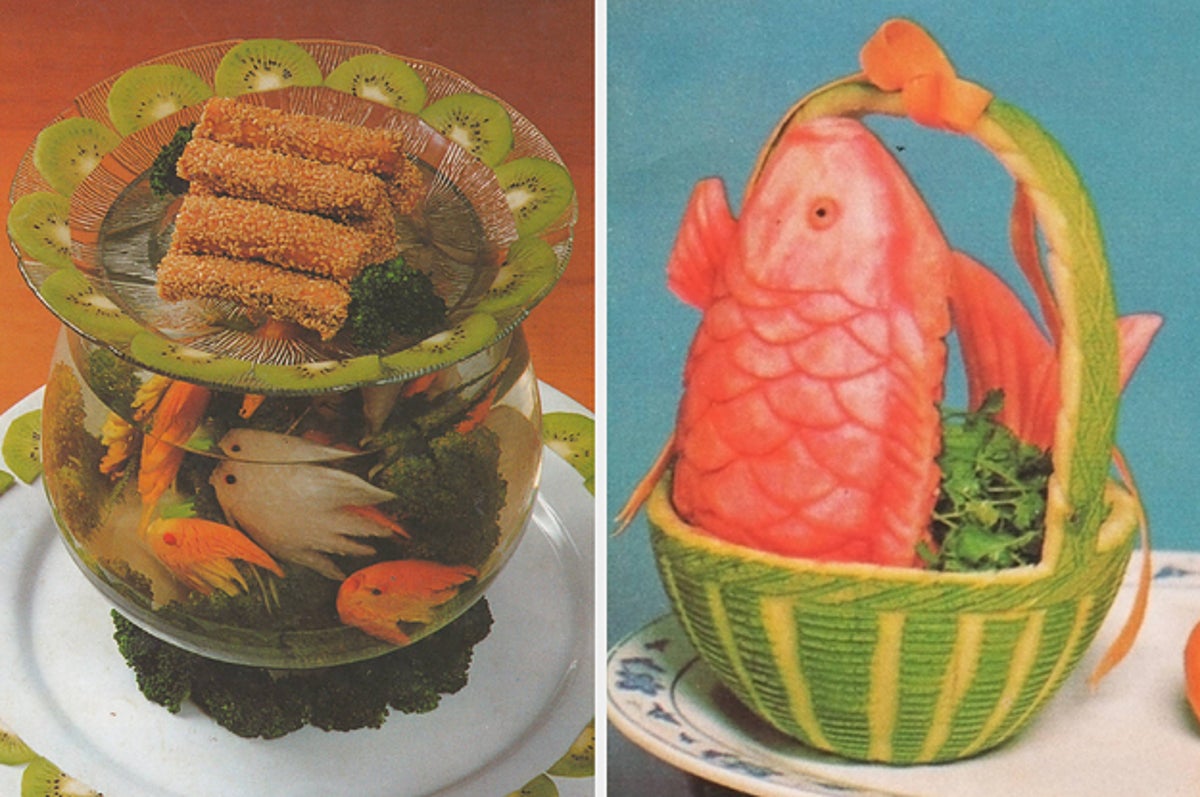
"Golden Pheasants Welcome Spring," prepared by Lu Jiaming
Dieter Mackenbach, the person behind the Instagram @chinese_plating, never would have guessed that a trip to the local library would send him on a path toward being obsessed with culinary history. Mackenbach is the person behind the Instagram @chinese_plating, which posts images of 20th-century Chinese food design in archival magazine collections, highlighting their intricate creations. The images are fun to look at — and they offer a new perspective on the cuisine, telling historical stories and showcasing impressive techniques.
“Everywhere I've lived, I've always made extensive use of the local libraries. I spent a lot of time in the Chinese National Library in Beijing and became really interested in Chinese culinary magazines,” Mackenbach said, specifically citing the ’80s magazines China Culinary and Sichuan Gastronomy. He checked them out from the library and started taking pictures because he was fascinated by the dishes; he then shared them on Instagram.
"Crab Roe Dumplings,"
A lot of the food in these magazines is from culinary competitions that were designed to demonstrate a chef’s expertise in knife carving and food presentation. There's also a strong emphasis on poetic composition and whether the dishes make references to historical events or literature. Christopher Tan, a food journalist turned cookbook author, worked as a reporter for a local fine food and wine magazine in the ’90s. During this time, he watched teams of professional chefs from around the world — Europe and Asia — compete in Singapore and produce complicated work that he said “would fit right in with the @chinese_plating photos — tons of stripes, patterns, three-dimensional work, vegetable and dough carvings, what have you.” He likens the work to the level of craft apparent in some episodes of The Great British Bake Off.
“One thing that stretches through is an awareness of symbolism,” he said, “the use of foods with particular qualities for what they evoke, over and above their sensory attributes.”
"Bamboo Fungus and a Fish Thread Soup"
A step up from traditional home cooking and plating is special festive and heritage cooking, which is done for important occasions such as Lunar New Year, Taoist holy days, or weddings. More time and expense are allotted to making traditional delicacies and dishes for these occasions, and their makers are expected to exercise their craft and skill to the utmost degree.
As for @chinese_plating, the account is photographic evidence for how varied Chinese food can be, Mackenbach said. “This is obviously not everyday, common food; most people throughout Chinese history absolutely do not eat such exorbitant dishes,” he added. “It can be quite wasteful, and some of it is not even meant to be eaten — the raw pumpkin carving, for example. It was mostly for show, for business meetings or extravagant occasions.” He claimed that this elaborate plating style stems from a tradition of Chinese cultural elite and literati putting on events and banquets.
"Ghostly New Year Toast," prepared by Lu Fei
“China as a whole takes their plating seriously. How my mom plates food at home, it's very thought-out and not natural. In culinary school, I was always told to make things look natural. But then you take something like this, and you can't deny it's beautiful,” said Calvin Eng. Eng is a former chef at Win Son, and is in the process of opening up Bonnie's, a Cantonese-American restaurant in Brooklyn. He's also a fan of the account. He said that it’s great to see the love and care that people put into these dishes in the past, and he hopes it encourages other people to pursue Chinese food further.
There has been a lot of talk in the last few years about shifting the perceptions of Chinese food in the US, and people want to emphasize the diversity, sophistication, and healthiness of Chinese food.
“Many high-end restaurants in China now copy Japanese and Scandinavian minimalist plating, which is not as individual to the country and kind of falls within the general minimalism whitewashing of everything. People send messages to thank me for sharing, claiming that it really gives them a sense of pride in their culture,” Mackenbach said.
"Good Luck and Great Prosperity," prepared by Chen Qinghua
Instagram is blocked in China as a whole, so Mackenbach does not have many followers from there commenting on his posts. The account’s photos have been shared on Weibo, China's popular Twitter substitute, Mackenbach said he was delighted to read through about 100 comments from people who remembered seeing such plating as kids.
He said that some people see this “maximalist food design phenomenon” as tacky or not in vogue. “Some Chinese people lament this style, but I think it has its place,” said Mackenbach.
“It does preserve a piece of food history,” said Grace Young, a cookbook author who has advocated saving restaurants in Manhattan’s Chinatown. “This food comes from that era in China when wealthy people not only wanted good food, but they wanted something that was pleasing to the eye.”
The sentiment is similar, she said, to the tradition of dim sum. “‘Dim’ is to touch and ‘sum’ is your heart [in Cantonese]. It's little things to touch your heart, which of course meant to please, to delight, to fancy.” It’s the same philosophy behind the over-the-top presentation in the magazines, that food should be something to revel in and to celebrate.
"Crystal Dragon Dumplings," prepared at the Chengdu Military District Wangjiang Hotel,
"Penguin Dumplings," prepared by Jiang Jianping
"Angelfish Rolls," prepared by Yu Tingcai
"Bamboo Announces Peace," prepared by Cao Zhiqing
"Nostalgia," prepared by Wu Zhiguo
https://ift.tt/3pfHZ09
food

Tidak ada komentar:
Posting Komentar